Erich
Lessing
Erich Lessing in Vienna in 1955. In the post-war years, he
said: "I wanted to tell the truth about the pain, death and destruction
that Europe was facing." (Credit: Erich Hartmann / Magnum Photos
Erich Lessing, self-taught photojournalist who fled the Nazi
annexation of Austria as a teenager in 1939 but returned after World War II to
document Europe's political and cultural renaissance, covering numerous events
in post-war Europe, such as the anti-Soviet revolt in Hungary. He died on
August 29 in Vienna. He was 95 years old.
His death was announced by Magnum Photos, the agency that
recruited him in 1951 after returning from Israel, where he had made a living
driving a taxi, selling cameras, raising tents on a kibbutz, and taking photos
of kindergarten classes and of mothers with their children on the beach near
Tel Aviv.
After that Lessing would return to Europe, much less that he
would return to Vienna permanently, might seem inconceivable given the
childhood memories his hometown would invoke. His father died of cancer when he
was 10 years old. His mother was left there when Erich emigrated to what was
then Palestine and, like his grandmother, was murdered in a German
concentration camp.
"He wanted to show what life was like after the
war," he told The Guardian in 2016.
“I wanted to tell the truth about the pain, death and
destruction that Europe was facing while trying to get out of the mess”
First for The Associated Press, then for Magnum, and in dozens
of magazines, newspapers, and dozens of books, Lessing quickly emerged as a preeminent
chronicler of the second half of the 20th century.
The streets of Katowice, the most important mining town in
Poland, in 1956. (Credit: Erich Lessing/Magnum Photos)
He photographed President Dwight D. Eisenhower in 1955 in
Geneva, tipping his hat as a beam of light crossed his face; Jubilant Viennese
outside Belvedere Palace as the Allied occupation of Austria ended that year;
General Charles de Gaulle saluting a fading shadow of French troops in Algeria
in 1958; and Nikita S. Khrushchev melodramatically wielding an ax 70 miles from
Paris after emerging from a summit conference with Eisenhower in 1960.
President Max Petitpierre of Switzerland greets President
Dwight D. Eisenhower in Geneva in 1955. (Credit: Erich Lessing/Magnum Photos)
Lessing worked briefly as a war photographer in 1956, covering
the Hungarian revolution against Soviet rule. But it soon became more focused
on social and cultural issues, including Eastern Bloc beauty pageants and
post-war bar mitzvahs in Poland, film sets, and art, including masterpieces
from the book "The Louvre: All the Paintings." (2011).
Lessing said that he considered himself a craftsman, not an
artist.
“I never thought he was doing anything other than telling
stories,” he said. “The camera became the medium through which I did it, but I
don't carry a camera everywhere. For me, it's simply the means to a very
specific end. I see the world through my eyes and not through a camera
viewfinder.
“I don't interpret or adjust anything in the darkroom,” he
continued. I am a realist photographer.
General Charles de Gaulle salutes an honor guard on a trip to
Algeria in 1958 during a nationalist war for independence there. (Credit: Eric
Lessing/Magnum Photos)
While he captured the highs and lows of humanity's political
manifestations, he was realistic about the effects of his work.
“I realized,” he once said, “that although reportage images
have the power to move the world, they do not have the power to change it.”
Lessing was born on July 13, 1923, in Vienna, to Jewish
parents. His father was a dentist, his mother was a concert pianist. As a
child, he took up photography as a hobby. “I'm self-taught,” he said.
A scene in Budapest in 1956 during the Hungarian uprising
against Soviet rule. Credit Eric Lessing / Magnum Photos
When he photographed Eisenhower, he recalled, many of his
colleagues relied on his new gadgets while he patiently waited for an
unforeseen opportunity.
“I had my Leica and that was it,” he recalled. “I looked at
them all and thought, ‘Usually there's one hurdle: When your movie goes
forward, that's when there's an interesting image to take.'”
Before he could finish high school, and with all of Europe
preparing for war, he escaped by ship to the port city of Haifa in Palestine,
where he studied radio engineering at technical school and served in Britain's
Sixth Airborne Division as a photographer. and pilot.
A beauty pageant attracted such a large crowd in the coastal
town of Sopot in post-war Poland that he had to be moved to the roof of a
casino. Credit: Erich Lessing / Magnum Photos
He returned to Austria in 1947. David Seymour, Magnum's
legendary co-founder with Robert Capa, hired him as a freelancer in 1951. He
joined the agency full-time in 1955 and became a part-time contributor in 1979.
In 2013, donated some 60,000 images to the Austrian National Library.
He is survived by three children from his marriage, to Traudl
Wiglitzky, a Time magazine journalist, who died in 2016; four grandchildren; a
great-grandson; and his second wife, Renée Kronfuss-Lessing. His daughter
Hannah Lessing is general secretary of the National Fund of the Republic of
Austria for Victims of National Socialism.
A truck collecting bodies on the streets of Budapest during
the Hungarian uprising. (Credit: Eric Lessing/Magnum Photos)
Source: New York Times – Translation: Silvia Schnessel
With affection,
Ruben





















































